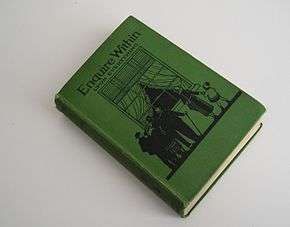Enquire Within Upon Everything

Enquire Within Upon Everything was a how-to book for domestic life, first published in 1856 by Houlston and Sons of Paternoster Square in London. The editor was Robert Kemp Philp.[1] It was then continuously reprinted in many new and updated editions as additional information and articles were added.
Topics
The book was created with the intention of providing encyclopedic information on topics as diverse as etiquette, parlour games, cake recipes, laundry tips, holiday preparation, and first aid:[2]
- "Whether You Wish to Model a Flower in Wax;
- to Study the Rules of Etiquette;
- to Serve a Relish for Breakfast or Supper;
- to Plan a Dinner for a Large Party or a Small One;
- to Cure a Headache;
- to Make a Will;
- to Get Married;
- to Bury a Relative;
- Whatever You May Wish to Do, Make, or to Enjoy,
- Provided Your Desire has Relation to the Necessities of Domestic Life,
- I Hope You will not Fail to 'Enquire Within.' " (Editor's introduction.)
History

The early editions of this book contained 3,000 short pithy descriptions and was one of a set of 20 books.[3] The book was a popular addition to the Victorian (and later post-Victorian) home. By 1862 the book was sold 196,000 times;[3] by the 89th edition, some 1,180,000 copies had been published. With the release of the 113th edition, this number had risen to over 1,500,000 and by 1976 was in its 126th edition.[4] Modernised versions were still in print as late as 1994.[5][6]
Agatha Christie used Enquire Within Upon Everything as an important clue in the Hercule Poirot detective novel, Hallowe'en Party.
Tim Berners-Lee named his precursor of the World Wide Web, ENQUIRE, after this work in 1980.[7][8]
- "When I first began tinkering with a software program that eventually gave rise to the idea of the World Wide Web, I named it Enquire, short for "Enquire Within upon Everything", a musty old book of Victorian advice I noticed as a child in my parents' house outside London. With its title suggestive of magic, the book served as a portal to a world of information, everything from how to remove clothing stains to tips on investing money."[9]
References
- ↑

- ↑ Culshaw, Geoff (September 2004). "Article: Enquire Within Upon Everything". Shropshire Family History Society Journal. pp. 118–120. Archived from the original on 16 September 2007. Retrieved 7 January 2010.
- 1 2 "History of the Web". Oxford Brookes University. 2002. Archived from the original on 25 September 2010. Retrieved 20 November 2010.
- ↑ Van de Walle, Étienne; Renne, Elisha P. (2001). Regulating menstruation: beliefs, practices, interpretations. University of Chicago Press. p. 128. ISBN 0-226-84744-6.
- ↑ PICARDIE, JUSTINE. "ETCETERA / Home Thoughts". independent.co.uk. Retrieved 30 January 2017.
- ↑ "Enquire Within Upon Everything: The Ultimate Problem-solver (Helicon General Encyclopedias)". AbeBook.com. Retrieved 30 January 2017.
- ↑ Simon Jeffery; Chris Fenn; Bobbie Johnson; Elliot Smith & John Coumbe (23 October 2009). "A people's history of the internet: from Arpanet in 1969 to today". London: The Guardian. pp. See 1980. Retrieved 7 January 2010.
- ↑ Finkelstein, Anthony (15 August 2003). "Enquire Within Upon Everything". ICT Portal. BBC. Archived from the original on June 21, 2003. Retrieved 7 January 2010.
- ↑ Press, Gil. "A Very Short History Of The Internet And The Web". forbes.com. Forbes. Retrieved 30 January 2017.
External links
| Wikimedia Commons has media related to Enquire Within Upon Everything. |
- 1894 edition at Project Gutenberg
- Google Books Version (1865 Edition)
- 1930 edition Fully previewed at Amazon. Accessed January 2010
- Interactive web rendering of 1884 edition. Accessed January 2010
- 1856 (first) edition at the Internet Archive. Accessed September 2016